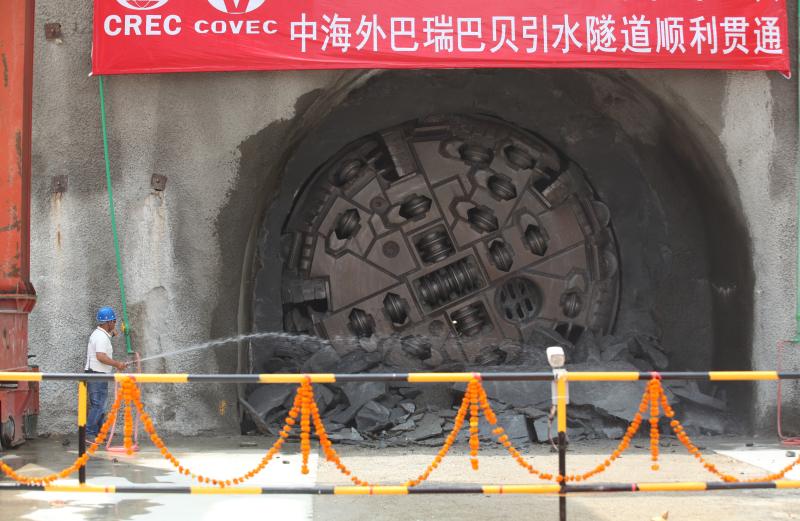Nepal stands to benefit from BRI
- By Ritu Raj Subedi
 0 Comment(s)
0 Comment(s) Print
Print E-mail China.org.cn, April 20, 2019
E-mail China.org.cn, April 20, 2019

Nepal's President Bidya Devi Bhandari will visit China on April 24 and attend the second Belt and Road Forum for International Cooperation, which will be held in Beijing on April 25.
Her participation in the BRI Summit is expected to give momentum to development projects under the Nepal Belt and Road Initiative (BRI) framework and take bilateral relations to new heights.
Nepal joined the BRI in 2017, but the two nations are yet to select and implement specific BRI projects.
Nepal and China will likely sign the protocol of the Nepal-China Transit Transport Agreement (TTA) during Bhandari's visit. The two countries finalized the TTA wording in Kathmandu in September last year.
The TTA protocol is crucial for Nepal as it grants the landlocked country access to four seaports in Shenzhen, Lianyungang, Zhanjiang and Tianjin and three dry ports in Lanzhou, Lhasa and Shigatse.
Nepal's access to Chinese ports has ended its sole dependence on India for its transit trade, linking its economy with the world's second-biggest market.
President Bhandari's visit will advance the bilateral ties of political trust and economic cooperation. To make the visit more fruitful and results-oriented, experts have suggested that the President's team should consist of finance, energy, and transport ministers.
Dr. Upendra Gautam, general secretary of China Study Center Nepal, said, "The bilateral meetings should be arranged in advance with an agenda and a follow-up action plan. The Chinese leadership makes decisions holistically whereas sectoral ministries hold technical negotiations in their respective areas."
It is imperative for Nepal to prioritize the development of its energy and transport sectors, enhancing the trans-Himalayan connectivity between the two nations, which requires the construction of cross-border transmission lines, railways, and roads to be completed.
During Prime Minister Khadga Prasad Sharma Oli's visit to China in June last year, the two sides agreed to speed up the implementation of the Memorandum of Understanding on Cooperation under the BRI. This cooperation will boost various areas, such as ports, roads, railways, aviation, and communications, within the overarching framework of trans-Himalayan Multi-Dimensional Connectivity Network.
President Bhandari's April visit offers an opportunity to discuss the much-talked-about Kerung (Gyirong)-Kathmandu railway, which is considered as a game changer in the geo-strategic map of the region.
The Nepalese government has prioritized the construction of the railway and claims the Detailed Project Report (DPR) will be finalized within six months.
China First Survey and Design Institute conducted its pre-feasibility study in December last year. However, the two nations are yet to decide how the railway that passes through freezing Himalayan zones will be funded. In addition to the huge investment required, geological insight and advanced technology are also essential in completing the ambitious project.
Bringing Chinese railway technology into Nepal was on the agenda of all major political parties during the 2017 elections. One factor leading to the sweeping electoral victory of the Oli-led Left Alliance party was its promise to implement the landmark Transit Transport Agreement in the wake of India's unofficial 2015 economic blockade of Nepal.
Dr. Gautam said that President Bhandari's visit could be instrumental to a financial package agreement for BRI projects in Nepal.
Following the restoration of political stability and formation of a strong government, Nepal is poised to achieve rapid economic growth. The country even has a motto: Prosperous Nepal, Happy Nepali. This reflects the Nepalese yearning for political stability and economic prosperity.
For Nepal, the BRI has become a viable instrument to boost investment, connectivity, and trade. It will effectively connect Nepal with the multi-modal transport networks of China. Nepal will also be connected to the 21st Century Maritime Silk Road with access to the Port of Guangzhou in south China and the Gwadar Port in Pakistan through Tibet.
Therefore, Nepal stands to accrue enormous benefits from the BRI, providing Nepal with leverage in the conduct of geopolitical and economic relations with countries in the trans-Himalayan region and beyond.
Ritu Raj Subedi is Deputy Executive Editor of The Rising Nepal.
Opinion articles reflect the views of their authors, not necessarily those of China.org.cn.
If you would like to contribute and have specific expertise, please contact us at opinion@china.org.cn.





